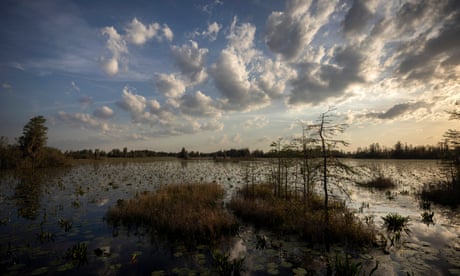- by foxnews
- 04 Feb 2025
‘Why mine so close?’: the fight to protect the pristine Okefenokee swamp
‘Why mine so close?’: the fight to protect the pristine Okefenokee swamp
- by theguardian
- 02 Apr 2023
- in news

Humans, as a general rule, are rather unkind to swamps. They are disparaged as rotten places that must be drained, either literally, to make way for farmland and houses, or metaphorically, to make way for demagogues. It's to this backdrop that one of the last remaining intact large swamps in the US, a pristine wetland almost unrivaled anywhere in the world, finds itself under threat from a planned mining project.
The Okefenokee swamp, found in the deep southern reaches of Georgia, may lack the fame of the fabled national parks of the US, but it is no less remarkable. Untouched by development, the 440,000-acre (180,000-hectare) swamp is a sort of time machine, offering an idea of what this mosaic of pine islands, with its riot of wildlife, would have looked shortly after its formation about 7,000 years ago.
"There's nothing like it, certainly not in North America," said Rhett Jackson, a hydrologist at the University of Georgia. The hydrological plumbing of the Okefenokee is still intact and its relative isolation means it is free of invasive animals and plants, unlike the larger and more troubled Everglades to the south, which has been torn apart by agriculture and is overrun by introduced pythons and iguanas. "I've never seen a cleaner piece of land than this," said Michael Lusk, manager of the Okefenokee national wildlife refuge. "This is what a large wetland is supposed to look like. It's unique."
Cruising the Okefenokee by boat at dusk offers a glimpse of its glories. Spanish moss dangles from cypress trees as the snouts of alligators poke out from the tea-colored water, blackened by the peat soil that underlies this sprawling ecosystem. An owl is perched on one tree, a pileated woodpecker on another. There are more than 200 species of birds, 40 types of mammals - including bears and deer - and 50 species of reptiles here.
There are more than 600 types of plant too, with lilies trembling like clattered cymbals as the boat passes by. A hefty alligator, known as Big Papa by guides, lounges torpidly by the water, soaking up the last dregs of sunlight. Ibises and egrets roost in a stand of nearby trees, resembling large flapping balls of cotton. There is no sludge, and no foul odor.
Far from the tendrils of suburbs or oil or gas drilling, the swamp has endured unmolested bar some early timber cutting, even if its backwoods location has provided it a certain obscurity. Still, more than 300,000 people visit it each year - it is particularly popular with Germans, park officials say. It has been a national wildlife refuge since 1937 and 350,000 acres (142,000 hectares) were given national wilderness area protection, the highest federal safeguard, in 1974. "It's one of the most beautiful places in the world, so why shouldn't we value and protect this as much as we would the Grand Canyon or Yellowstone?" asked Lusk.
We may value natural landscapes that have painstakingly evolved over millennia, but, on the other hand, there is also the monetary value of strip-mining such a place for minerals that can be used to put pigment into paints and toothpastes. The latter priority is the focus of Twin Pines Minerals, an Alabama-based company that has proposed a mining project about 3 miles (5km) from the south-east edge of the Okefenokee.
Twin Pines wants to slice open a geological formation called trail ridge, a long, raised area that was once a barrier island in prehistoric times but now acts as a sort of eastern boundary to the swamp, holding it in place rather than letting its water seep into the Atlantic Ocean. The company plans to burrow about 50ft into trail ridge, extracting titanium dioxide, which can be used in paints, toothpaste and medical equipment, before backfilling the sand.
It will be "physically impossible" for the Okefenokee to be harmed by this process, Twin Pines has insisted, but hydrologists and the federal government disagree, citing supposed flaws in the company's reasoning.
In a submission to Georgia's environmental protection division, which is currently mulling a permit for the 580-acre (235-hectare) mining project, experts from the National Park Service said there are a "series of critical shortcomings" in Twin Pines' environmental assessment of the project's impact. A separate group of 45 independent scientists wrote that the mining "has a high likelihood of causing permanent damage to the swamp and surrounding areas".
Deb Haaland, the US interior secretary, wrote to Brian Kemp, the Georgia governor, in November to warn of the "unacceptable risk" the project poses to the Okefenokee, as well as its cultural values. Haaland, who has thrown her weight behind the Okefenokee being named a Unesco world heritage site, noted that the swamp is part of the Muskogee ancestral homeland and that past settlements and burial mounds have been found on sections of trail ridge. "The swamp ecosystem is a treasure for the people of Georgia, our nation and the world," she wrote.
The swamp is the headwaters for two rivers - the Suwannee and the Saint Marys, the latter forming part of the state border with Florida - and is essentially a shallow dish that receives about 80% of its water from rainfall. Twin Pines' dig pits would fill up with about a million gallons of water each day that would then evaporate, effectively parching the swamp of its nourishment, according to Jackson, the hydrologist.
"If you remove water that would've supported the swamp then you make it far more prone to drought," he said. "Once that happens you have all sorts of social and ecological effects - you won't be able to paddle on it as often and fires will become much more likely. The mine wouldn't bother me somewhere else but it's next to this pristine swamp, and we have drained all the others. This is what we have left."
Wildfires have torn through this place before - ghostly stands of dead trees linger from a huge 2011 blaze. But more frequent fires would fundamentally alter a place that has water only a few feet deep in most places, in a region predicted to suffer more intense droughts due to the climate crisis. "Recently the fires seem like they're becoming more frequent," said Lusk.
"If it gets drier, we will get more fires and that will kill more of the trees and the wildlife. The ecosystem doesn't have a chance to recover, which is something we're concerned about. Every inch counts, in terms of the water."
A coalition of more than 40 organizations has vowed to fight the mining project, with a recent public comment period deluged with people imploring Georgia to reject the proposal. A spokesperson for the Georgia environmental protection division said it would take "several days to several months" to assess the project. Steve Ingle, president of Twin Pines, said the company would "provide any additional information needed to eliminate doubt" over the mining's impact on the swamp.
The battle has, at least, stirred something in locals who perhaps took the swamp for granted in the past. Antwon Nixon, a local pastor, said he used to visit the Okefenokee as a child, four decades ago, where he would admire Oscar, a legendary 13ft alligator who lived for nearly a century before dying in 2007.
When he heard of the mining threat to the swamp, Nixon went to the refuge's visitor centre for the first time in years, where he saw Oscar's mounted skeleton. The bones were put on display after the animal's stomach, which included part of a flagpole and at least one pet dog, was disgorged.
"Everyone knew Oscar, he just chilled out there like he owned the place," said Nixon. "I've got a new appreciation for the swamp, but it's not valued enough. It's too valuable to even take the risk with this mining. Why mine so close to it? That's just putting money above anything else."
Nixon has taken to campaigning in his home town of Folkston, near the swamp, and traveling to Atlanta to press lawmakers, all in an effort to halt the Twin Pines project. "It's more a spiritual thing for me than anything else," he said. "This is Eden. I feel like I'm literally tied to it, it's part of me. It consumes my mind."
- by foxnews
- descember 09, 2016
Travelers flock to top religious landmarks deemed 'most Instagrammable'
Travelers visiting religious landmarks across the world may see a photo opportunity that's worthy to share on social media. Here are 10 popular spots, plus some attractions in the U.S.
read more


